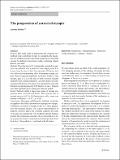The progression of corrected myopia
Author(s)
Medina, Antonio
Download417_2015_Article_2991.pdf (149.5Kb)
PUBLISHER_POLICY
Publisher Policy
Article is made available in accordance with the publisher's policy and may be subject to US copyright law. Please refer to the publisher's site for terms of use.
Terms of use
Metadata
Show full item recordAbstract
Purpose: This study seeks to demonstrate the existence of a feedback loop controlling myopia by comparing the prediction of a feedback model to the actual progression of corrected myopia. In addition to theoretical results, confirming clinical data are presented. Methods: The refraction of 13 continuously corrected myopic eyes was collected over a period of time ranging from 4 to 9 years from the time of their first correction. Refractive data was collected in an optometry office from myopic young subjects from the general population in Boston. Subjects were myopes, ages 2 to 22 at the time of first correction selected randomly from a larger population. All individuals were fully corrected with lenses; new lenses were prescribed every time that their myopia increased by 0.25 diopters or more. Subjects wore their spectacle lenses during the followed period. Results: Subjects exhibit a linear time course of myopia progression when corrected with lenses. The observed rate of myopia increase is 0.2 to 1.0 diopters/year, with a mean correlation coefficient r = −0.971, p < 0.005. Conclusions: This report establishes that feedback control theory applies to the clinical phenomenon of progressive myopia. Continuous correction of myopia results in a linear progression that increases myopia. The Laplace transformation of temporal refractive data to the s-domain simplifies the study of myopia and emmetropia. The feedback transfer function predicts that continuous correction of myopia results in a linear progression because continuous correction opens the feedback loop. This prediction is confirmed with all subjects.
Date issued
2015-04Department
Massachusetts Institute of Technology. Research Laboratory of ElectronicsJournal
Graefe's Archive for Clinical and Experimental Ophthalmology
Publisher
Springer Berlin Heidelberg
Citation
Medina, Antonio. “The Progression of Corrected Myopia.” Graefe’s Archive for Clinical and Experimental Ophthalmology 253.8 (2015): 1273–1277.
Version: Author's final manuscript
ISSN
0721-832X
1435-702X